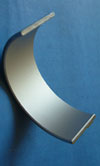Why and when to develop an equivalent for leaded bearing materials?
 In the July 2010 issue of RET-Monitor, keyword: bearings, I wrote about lead-free bearings and possible engineering concerns surrounding their introduction. Extending the search for the reasons behind why the substitute for leaded bearing materials is not yet embraced by the race engineers led to a short interview with a leading supplier of competition bearing shells.
In the July 2010 issue of RET-Monitor, keyword: bearings, I wrote about lead-free bearings and possible engineering concerns surrounding their introduction. Extending the search for the reasons behind why the substitute for leaded bearing materials is not yet embraced by the race engineers led to a short interview with a leading supplier of competition bearing shells.
In addition to possible sensitivity issues concerning roundness (shape and steps in the circumference of the bearing bore) and the lower conformability and embedability of the unleaded, harder materials, the temperature inside the bearing is considered to be of major importance in the selection of the bearing material.
The temperature in the main bearing needs to remain within certain limits so as not to lead to deterioration of the oil film, in terms of its thickness and the oil quality. Above the temperature limit, the lubrication between crankshaft and bearing will quickly fail, leading to major engine damage. Racing engines will run up to 50% smaller oil film thicknesses than a typical OEM roadcar, which run in the region of 0.5 to 1 µm.
The oil temperature inside the bearing is a consequence of several factors, based on the main oil gallery temperature and mass flow, and depends on oil heat-exchanger capacity and the amount of oil going through it. It is this oil, which is fed to the bearings, where a temperature rise occurs due to friction loading, based on rotational speed of the crankshaft and crank train loading.
Oil temperature in the main oil gallery can be limited by increasing oil mass flow or oil heat-exchanger size, or both. The nature of the racing game, however, is that the heat exchangers are chosen to be as small as possible due to the tight engine and vehicle package in relation to aerodynamic boundary conditions, and the oil mass flow is as low as possible in order to achieve the lowest possible oil pump driving power, and reduce friction losses in the engine. Given these contradictory boundary conditions, compromises need to be made to get to the best overall performance.
Taking these factors into account, it becomes clear that the thermal conductivity of bearing shell materials is of major importance in ensuring that the heat transfer from the oil itself, through the main bearings to the crankcase, is achieved as efficiently as possible. Current developments on the lead-free alternatives have progressed significantly on the roadcar side, but given the more extreme application in performance engines, further steps need to be taken to come to a true and reliable replacement of leaded bearings, which still have the advantage over their lead-free alternatives.
It will remain the task of the bearing suppliers to think of and further develop lead-free bearing material specs, with or without applying coatings to them, to achieve improved thermal conductivity as well as sufficient conformability and embedability to be able to compete. The addition of coatings might support in achieving these targets, especially for running-in behaviour, as long as it is taken into account that coatings are not always known for their good thermal conductivity properties.
As usual, market demand will determine the efforts going into these developments to achieve feasible products. The question remains though of how much 'back-up' the developments get from the legislative directives. As mentioned in the former article on lead-free bearings, the EU End-of-Life Directive applies in principle to the OEM roadcar markets only, but this Directive cannot be neglected by the racing industry in years to come.
And although it will be possible to introduce measures to make a controlled separation of lead-containing materials from worn-out racing engines much easier in comparison to the roadcar industry, the development towards the removal of all lead-containing components will need to be continued in order to achieve the 'green' racing environment this industry needs to remain acceptable in the modern world.
The question will not be whether but when the racing industry makes the step towards removing all lead from its race vehicles, and whether this will be at its own initiative. Until then though, it is my expectation that developments here will remain a low priority.
Fig. 1 - MAHLE Clevite bearings (Courtesy of MAHLE Clevite)
Written by Dieter van der Put